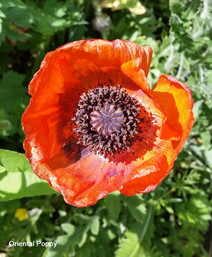What's in a Name?
- Clare
- May 27, 2020
- 4 min read
Gardeners often seem to be obsessed with plant names. The proper botanical names of plants seem to trip off the tongues of "proper" gardeners like Monty Don and Carol Klein, though it's a club I am definitely not a member of. I know a handful of "Latin names" which I am often afraid of using for fear of mispronunciation. I know this is silly and I feel I should make more of an effort and therefore I will try to include more botanical names in my blog in the hope that some will stick in my own mind!
The modern binomial system that we currently use for naming plants was developed in the eighteenth century by the Swedish botanist, zoologist and physician, Carl Linnaeus. Linnaeus is known as the "father of taxonomy" due to his work on the classification of plants, which was first published in the revolutionary Systema Naturae in 1735. This twelve page work grouped plants according to their reproductive parts, demonstrating order in a relatively uncomplicated way.

Linnaeus then turned his attention to the naming of plants which, up until that time, was confusing to say the least. Plants were known by their common names, which varied enormously between different geographical regions, or names were hopelessly long and descriptive. A species of viola in Linnaeus' time, for example, was called Viola floribus radicalibus corollatis abortientibus caulinis apetalis seminiferis, which is quite a mouthful!
Linnaeus formalised a two part "binominal" naming system which generally includes a generic name, which identifies the genus which the plant belongs
to, followed by a species name (which may be followed by a subspecies or cultivar). Names are written in a "Latin form", though may be derived from other languages or from prominent individuals. For example, the genus "Rhododendron" comes from the Greek "rhodos" (red) and "dendron" (tree) whilst "Forsythia" attributes its name to the Scottish botanist William Forsyth.
Linneaus' achievements brought order to a hitherto chaotic system. However, whilst I appreciate the usefulness of a standardised naming system, I still have a fondness for common plant names which seem an important part of our social history and often say more to me about the appearance of a plant than its Latin counterpart. For example, the name "foxglove" is more appealing (to me) than "Digitalis", though the fact that synonyms such as fairybell, fingerflower, witches' glove, fairy thimble and fairy cap are also used for the same flower, illustrates the need for standardisation.
Getting back to our own garden, the peonies are flowering and looking glorious, though the flowers themselves seem so large and cumbersome that I wonder how they manage to stay upright. We have four peonies in total, of varying shades of pink, though the darker flower shown in the second of the following images is certainly my favourite as it has a beautiful, strong, rose-like scent. It has moved house with us three times, though its travelling days are hopefully now over (as peonies can live for a hundred years, I hope it likes the spot!).
"And the wind upon its way whispered the boughs of May, and touched the nodding peony flowers to bid them waken." (Excerpt from Daybreak in a Garden by Siegfried Sassoon).
In addition to the peonies, more pinks and reds are appearing. Unfortunately, the foxgloves are suffering in the prolonged hot weather and I hope they survive long enough to produce seed. I am watering the garden of course but there is no substitute for rain water and I am mindful of the fact the foxgloves tend to prefer a slightly acidic soil.
As mentioned in a previous post, I have been attempting to cultivate a "yellow and cream" raised bed close to our small patio. I wanted this area to display flowers all year round, with a strong emphasis on scented plants as I always feel slightly cheated if a flower doesn't smell as good as it looks! Whilst it is looking a little overcrowded at the moment, and I will no doubt continue to make changes, I am generally happy with how the border has turned out (corner section shown below).

Currently flowering are three roses ('Arthur Bell' and 'Countess of Wessex') which were chosen for their repeated flowering and punchy scent, a yellow honeysuckle (Lonicera periclymenum 'Heaven Scent') and a Philadelphus ('Belle Etoile'), which is a relatively compact shrub, though very generous with its scented flowers. The Sisyrinchium striatum (aka 'pale yellow-eyed grass' or 'Mexican satin flower') is also still blooming well and (whilst it may be a controversial choice) the curry plant is just starting to flower. This was chosen partly due to its silver/grey foliage which compliments some of the other plants in the border, but it does have a very strong "curry scent" at certain times of year which may not be to everyone's taste!
At a lower level, the Cerastium tomentosum ('Snow in Summer') continues to impress, though our cat likes to sleep on it and therefore it does appear a little patchy in places. Helianthemum 'Ben Fhada' and a number of alpine strawberries also form a tumbling edging which will spread vigorously if left unchecked.
In hindsight, I probably should have chosen fewer plant varieties for more impact, but I am a sucker for buying plants! A few grape hyacinths, Scilla and bluebells also seem to have crept in, but I actually find that I like the addition of a little blue in early Spring.

As an added bonus, this flowering quince I trained against a fence has lost almost all of its white flowers but is starting to show the first signs of fruit!
The insects in the garden are as busy as ever. The Cotoneaster is still covered in bees, though I realised today that it seems to be particularly popular amongst types of bumble bee, whilst the honey bees prefer the thyme which flowers at a low level close by. The bees also seem to be particularly attracted to the blue of our small, creeping Californian lilac (Ceanothus) and the remaining perennial cornflowers (Centaurea montana).
The starlings are still chattering continuously in the garden and I wonder if they are here to stay. We also still see the goldfinches occasionally and our bird feeder is regularly visited by blackbirds, collared doves, wood pigeons, sparrows, a robin and (occasionally) a thrush. They are all welcome visitors, though I live in hope of seeing the kingfisher again and glance towards the river every time I venture into the garden.

































Comments